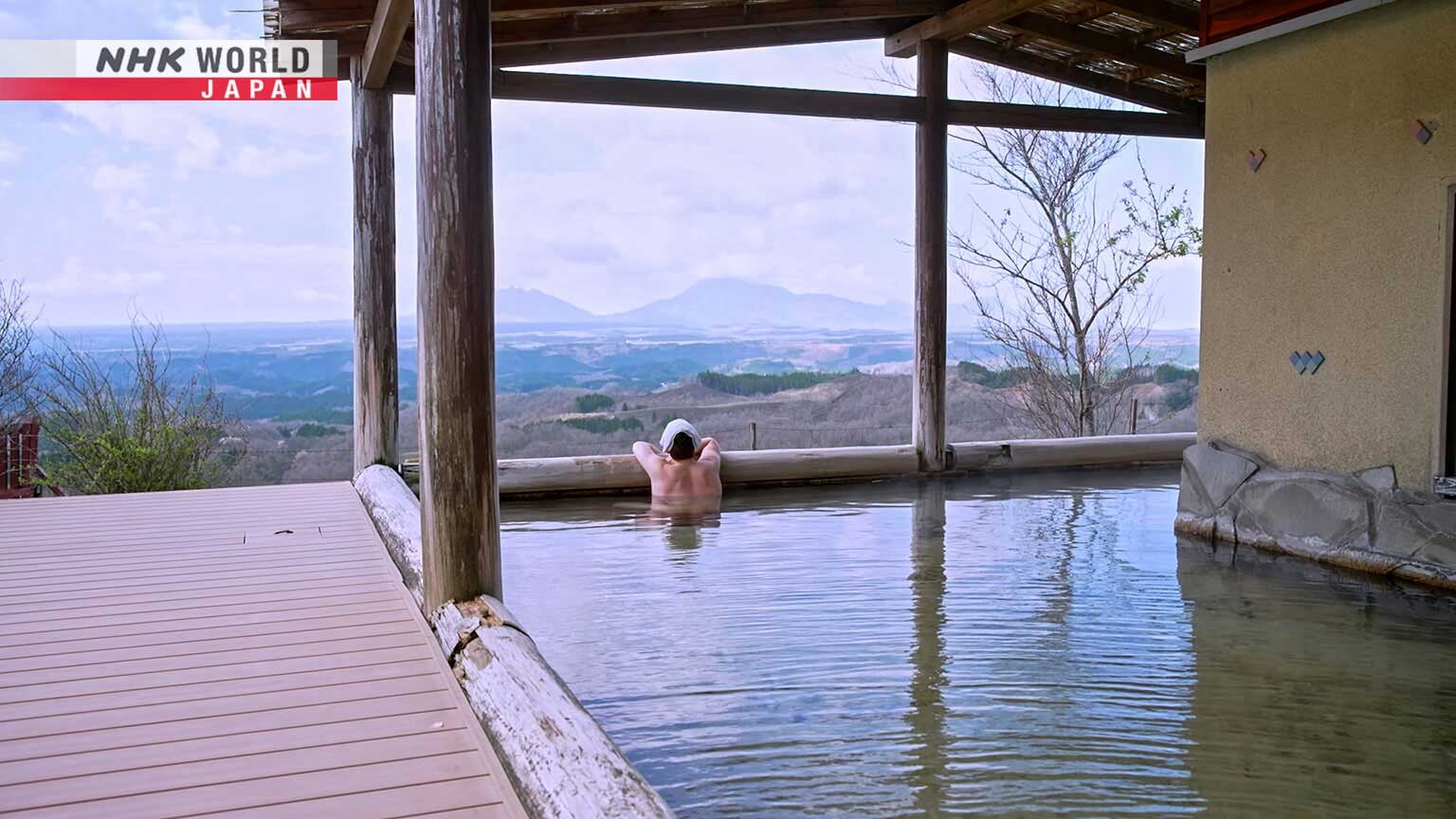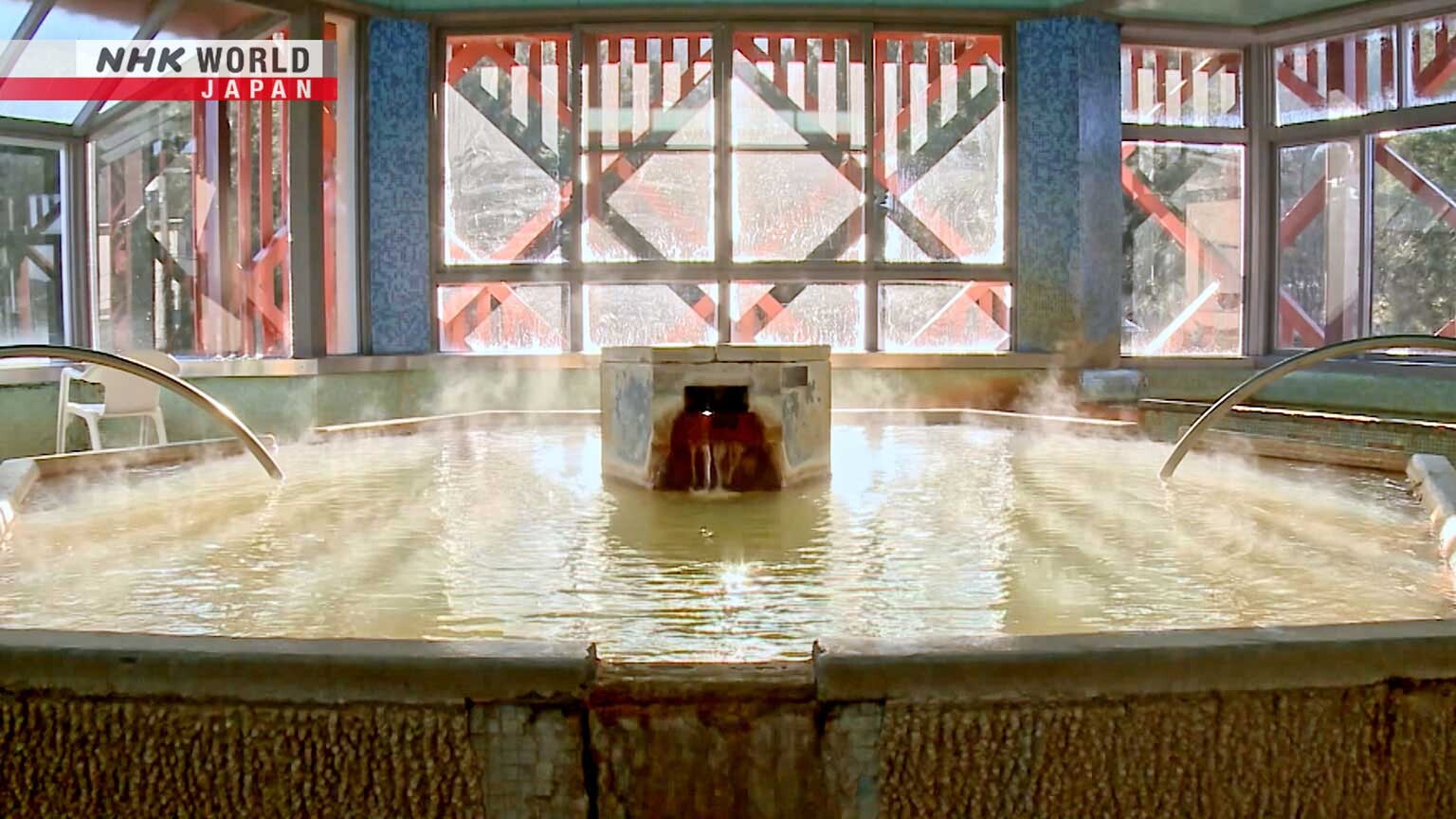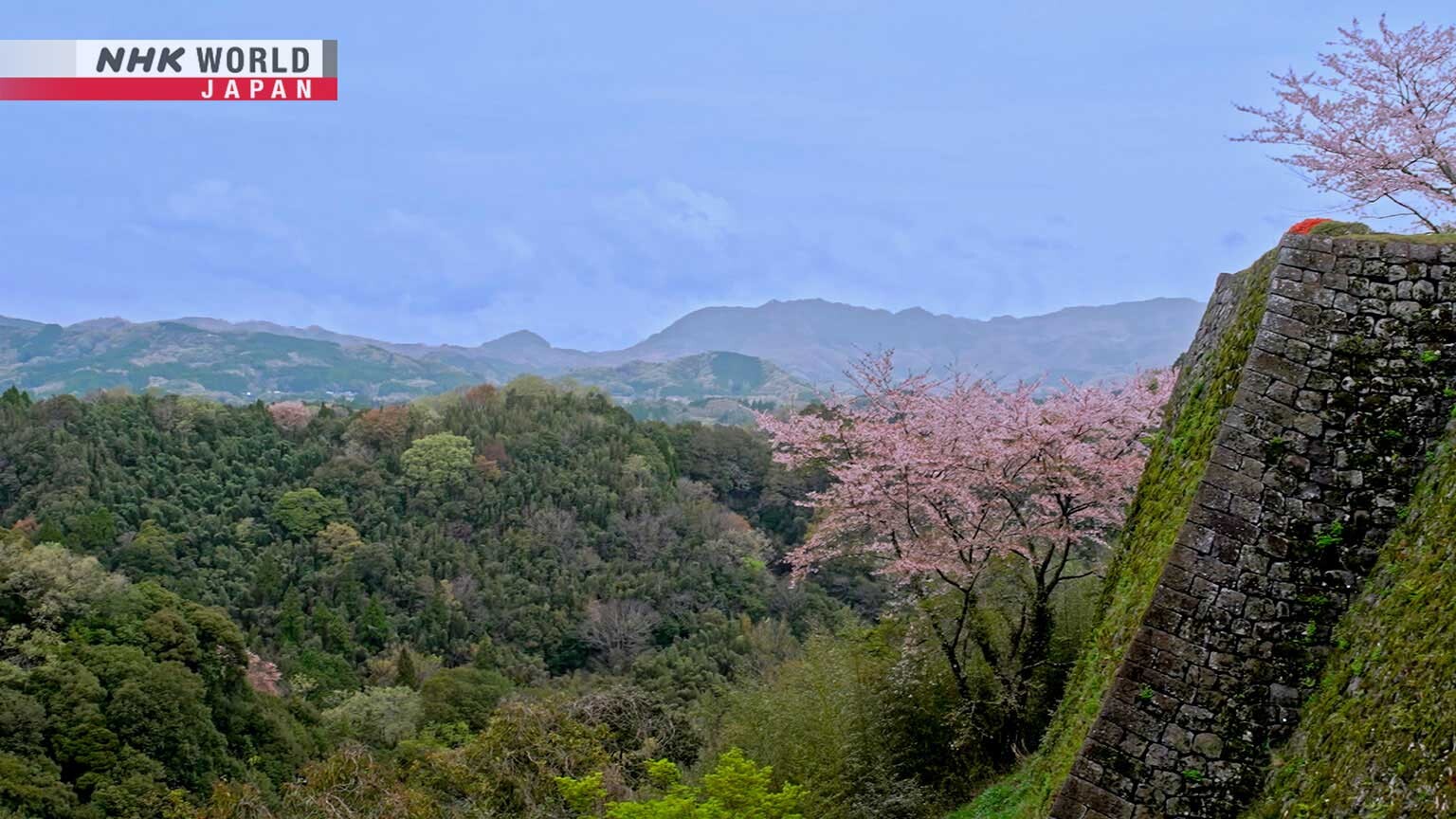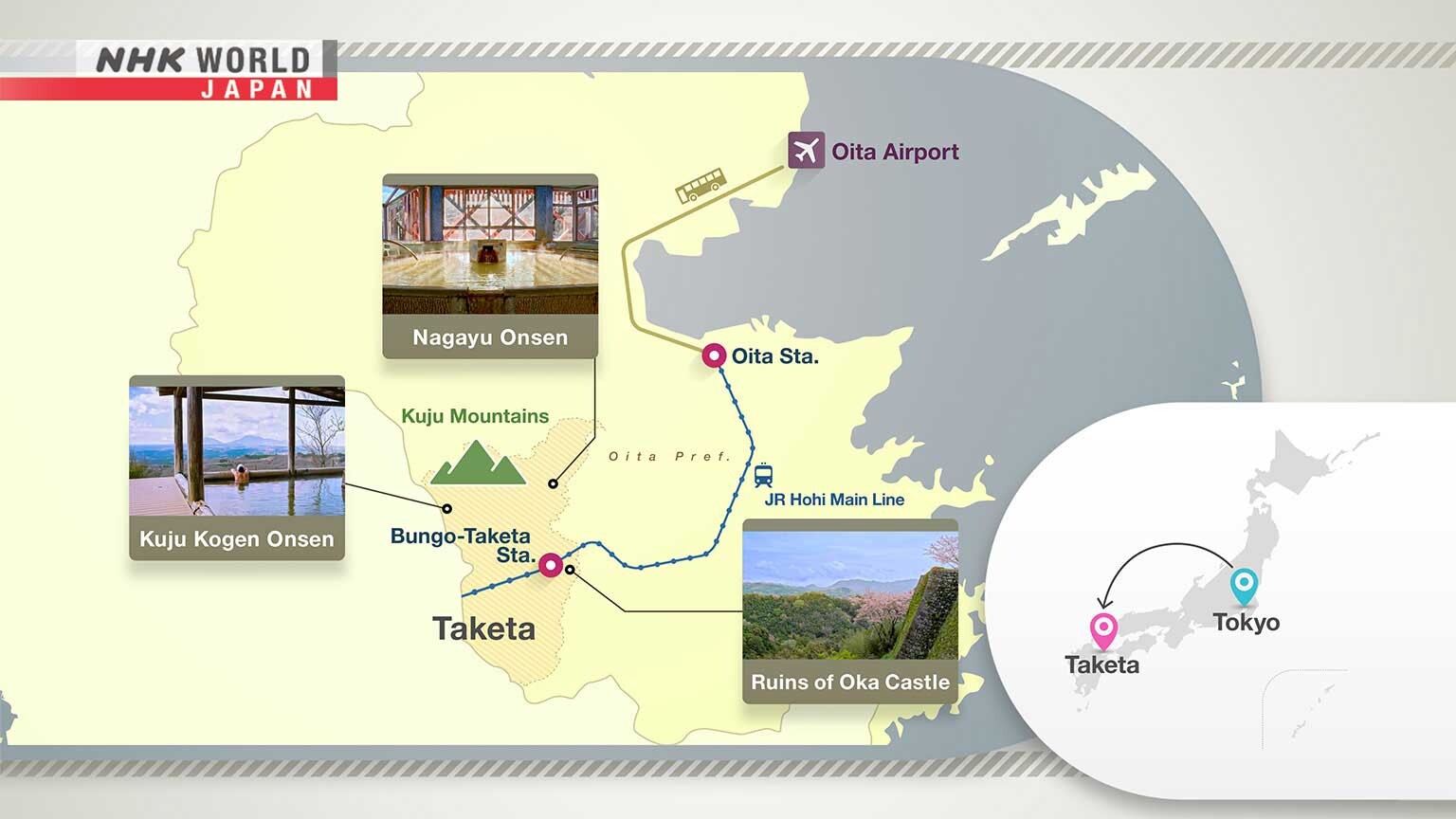Taketa: Onsen Bathing Old and New
People in Japan love bathing in hot springs, or onsen. And since the old days, it has been common for people to check into residential hot-spring inns for extended stays to boost their health, heal their aches and regain their well-being. This style of onsen therapeutics is known as Tōji. On this episode of Journeys in Japan, Kyle Card travels to Taketa City in Oita Prefecture to discover a contemporary style of Tōji therapy where visitors can recover their energy while enjoying the majestic natural environment along with some of the world's finest carbonated hot springs.
Kuju Kogen Onsen

These hot springs offer magnificent views looking out at the beauty of this vast upland area. The Kuju Mountain Range is often called the "roof of Kyushu."
Nagayu Onsen

These hot springs are known for the high carbonation of their water. With a total of 22 accommodations and hot spring facilities, visitors can enjoy a range of styles of hot-spring bathing, including therapeutic and exercise baths.
Ruins of Oka Castle

Originally built in 1185, Oka Castle is a designated historic site with an 800-year history. It occupies an impregnable rocky hilltop at an elevation of 325 meters. The walls are still visible, evoking the grand fortifications of ancient Japan.
Access

From Tokyo, flights to Oita Airport take about 90 minutes. From there, it's another two hours and 10 minutes by bus and train.
Transcript
"Journeys in Japan"
People in Japan love going to hot springs, or "onsen."
In the old days,
people used to check into residential onsen facilities for extended stays,
to boost their health and regain their strength.
Oita Prefecture is one of the most renowned areas for onsen hot springs.
And Taketa offers some of the best bathing.
Kyle Card is an actor from Canada
who has lived in Japan almost 20 years.
He's also a huge onsen enthusiast.
Happy wife, happy life.
It's the way we stay close. No barriers.
On this edition of "Journeys in Japan,"
Kyle steeps himself in traditional onsen bathing
that has a contemporary appeal.
It's a new approach to travel, based on health and well-being.
So good!
Taketa: Onsen Bathing Old and New
The city of Taketa lies 800 kilometers southwest of Tokyo
in Oita Prefecture,
near the center of the island of Kyushu.
Taketa boasts a wide variety of different hot springs.
Kuju Kogen Onsen lies in an upland area.
Nagayu Onsen has some of
the most highly carbonated hot-spring water in Japan.
Taketa Onsen lies in a historic castle town.
And Ogi Onsen looks across to the Kuju mountain range.
Right now, I'm located in the center of Kyushu, in Oita Prefecture.
And what you can see behind me
is known as the roof of Kyushu, the Kuju mountains.
They are a mountain range standing some 1,700 meters high,
and they're also active volcanoes.
Located in the north of Taketa City,
the Kuju mountains boast more than 20 volcanoes.
This area has been known as a center for hot spring bathing
since ancient times.
Kyle first came to Japan 18 years ago.
Since then, he has visited numerous hot springs across Japan.
And has even been certified as a so-called "onsen sommelier."
The Taketa City onsen region is said to be one of the top hot spring spots
among over 2,700 locations nationwide.
They even have public onsens outside along the river.
Wow.
For centuries, it has been common for people
to stay at hot springs to regain strength,
heal their wounds or recover from illness.
This style of onsen therapeutics is known as "toji."
For around 400 years,
Taketa has been a popular place for people to stay for toji therapy,
and it still has hotels offering long-term stays.
Taketa City has been a destination hot spring resort area
since ancient times.
Toji, it's kind of like European spa-style tourism,
slowing down and allowing oneself to be leisurely immersed in the flow of time.
Pretty luxurious if you ask me.
Oh! I've got to go!
Kyle is heading down to have a bath in fresh hot-spring water.
This bath is refilled at 9 AM every day.
Check this out.
A freshly filled onsen bath
and I am the first to use it for the day.
The film of natural hot-spring salts on the surface
after the bath is refilled is known as "yunohana,"
literally "hot-water flowers."
Now, one does not simply jump into the onsen right away.
There's a very important step you must not forget,
and that is showering or "kakeyu."
The first purpose is manners.
It's cleaning your body of any dirt or anything that may be on it.
You know, for the benefit of everyone else who's going to be using the bath.
And the second, is to prepare your skin and body
for the minerals of the bath and the temperature.
And now it's time to bathe.
And put it on top of your head.
Oh, that's the stuff.
To avoid placing a strain on your body,
it's best not to stay for long in the bath.
And lastly, the most important thing to remember is that
before and after a bath, don't forget to hydrate.
Now, there are all sorts of hot springs in Japan,
so I'm going to speak to a local expert to learn about
what kind of hot springs are here in Taketa.
Dr. Ito Kyo is a specialist in hot springs.
He practices what he calls "onsen therapy" in Taketa.
Please tell me what makes Taketa's hot springs special.
Taketa's hot springs are carbonated, which is very unusual.
They also have a wide range of temperatures.
- I see.
- That's right.
There is a wide range of ions and minerals in the hot water
and these can help promote healing in wounds and sores.
Taketa is promoting a more contemporary approach
to toji-style hot spring therapeutics,
taking advantage of the wide variety of hot springs in the city.
Please tell me about your approach to onsen therapeutics.
This is Taketa's "Golden Rule" for good health:
Warming the body, walking, eating, and laughing.
This is the way to refresh your energy.
Warming... walking...
eating... and laughing.
Visitors are encouraged to focus on these simple actions
which enhance the body's natural healing power.
- I'll definitely try this.
- I hope you do.
Taketa has been taking hints
from the recreational hot spring resorts found in Germany.
This facility offers consultations for people
before they start their onsen therapeutics.
The staff here are certified hot spring instructors.
We offer health consultations and suggest
the best style of bathing for each person.
So you create individual programs for visitors?
It's unusual to find a spa facility with instructors.
Yes, we give advice on bathing safely and effectively.
They offer advice on which hot spring is right for you,
as well as the temperature and the length of time you should bathe
according to your condition, your blood pressure or fatigue level.
Many people think toji therapy is only for elderly and sick people.
But we want young people to try it, to improve their health.
A hot spring soak makes your skin feel completely different.
There are also onsen facilities in Taketa where people can exercise
and undergo rehabilitation from injury or sickness.
This is a walking bath.
It's a modern addition to the toji approach
that combines hot-spring water with moderate physical exercise.
As you can see, there's some variations in the depth
which is really great for rehabilitation and relaxation purposes.
Different levels of like, resistance, you know?
It's actually a bit of a workout.
Taketa has a long history as a castle town.
Oka Castle was first built in 1185,
on an impregnable hilltop rising 325 meters above sea level.
After walking amongst its sheer cliffs and imposing stone walls,
it's easy to understand how Oka Castle was historically never conquered.
From about 400 years ago,
the town began to spread out around the castle.
The layout remains largely unchanged to this day.
Welcome.
You have a nice space here.
Thank you very much. We've been in business for 220 years.
Since the time of Oka Castle?
Yes. We used to provide sweets for the lord.
So can I eat the same sweets as the feudal lord?
That's right.
Right.
Oh, look at that "an."
That is wonderful.
There's a smooth and sweet anko.
A nice crunchy outer wrapping. It's so good.
Of course, you've got to pair it with the matcha.
Perfect pairing.
I can see why it's been around for hundreds of years.
Walking around the old town, you will come across local handicrafts.
This is a craft traditional to Taketa called "himedaruma."
Okay.
- Hello.
- Welcome.
- I like your workshop.
- Thank you.
Does this craft date back a long time in Taketa?
For nearly 370 years.
That long?
They've been displayed in shops here for centuries?
Yes. Every year the shops in Taketa's shopping district
display himedaruma dolls as a prayer for a peaceful year.
The face is modeled after a woman
who was the wife of a lower-level samurai in Oka Castle.
The idea is that the mother shines like the sun,
wishing for her husband and children to stay healthy.
Happy wife, happy life.
It must take a lot of effort to make so many of them.
I've been doing this for about 60 years.
Sixty years? That's amazing!
How do you like it? Do you enjoy working together?
It's fun. She's always positive.
All the work is done by hand.
Each one takes a week to make.
It looks like you'll keep doing this for a long time.
I'll do my best to carry on until I'm 100.
And I hope she does too.
Just like these "daruma" dolls, you'll never fall over.
Yes.
Taketa's hot springs are renowned
for having some of the highest concentrations of carbonic acid.
See the bubbles in the water?
There are so many.
Have you ever had a bath with so many bubbles?
It's my first time.
It's all free-flowing hot-spring water. Direct from the source.
Baths with bubbles like this are quite rare.
Are you all from Taketa?
Yes, we're all locals.
I've been bathing in this hot spring since I was a child.
I think it's the best.
We hope that people will enjoy the atmosphere
at each of the hot springs in this area.
It's nice to be able to meet like this.
It's the way we stay close. No barriers.
Not all the water in Taketa is hot.
Every day, 70,000 tons of natural spring water gushes through the city.
This water from the nearby mountains brings abundance in other ways.
This is an amazing place for growing vegetables.
It really is.
We grow about 50 different vegetables each year.
Great. May I take a look around?
Sure, come in.
This is a leaf mustard for salads.
It's red mustard.
These small leaves should be the best.
Wow. That color, beautiful.
Oh, that's delicious.
It's really fresh. So good!
It's that mustardy kick at the end. It's wonderful.
Fresh and mustardy.
Nice and spicy.
What an amazing color.
This is lettuce. It's at its peak now. It's really delicious.
Wow. Look at that beautiful color. It's almost glowing.
Oh, so fresh and crispy.
I've never had lettuce this good before.
Everything is grown organically. That's why it tastes so good.
Everything is so fresh and delicious.
What makes the vegetables in Taketa so special?
First of all, the water is very pure.
That is what makes the vegetables so tasty.
The altitude also causes a temperature differential
and that also makes them more flavorful.
It gives the vegetables a more concentrated flavor.
So we can grow many delicious vegetables year-round.
You have to have clean water.
That's right. And the right temperature.
It's a great place to grow our produce.
Kyle visits a restaurant that specializes in using produce grown locally.
Amazing. It all looks so delicious.
Please tell me what's on my plate.
This is a dish of venison with vegetables.
These are fresh ingredients from the Taketa area.
Because it's spring now, I'm using seasonal vegetables.
It all looks great!
Enjoy.
Look at all these colors.
The vegetables are just so fresh and just crisp.
And this dressing just has this kick to it.
It goes well with the fish too,
that umami of the fish just brings it all out.
And the presentation just yells spring.
Main dish, here we go.
All right, red wine sauce with "takenoko."
Here we go.
Now, that's a great sauce. That's just so good.
It goes so well with the deer, wow.
A little bit of that tang from the wine.
All right, we see some veggies here.
Some of the sauce on the veggies...
So crisp and fresh. My goodness, it goes so well with the sauce.
It's all just, for lack of a better word, perfect.
Actually, that's the perfect word for it.
The next stop for Kyle is the Kuju Kogen plateau.
In the Taketa area, the hot springs vary greatly,
depending on their location.
Kyle has come to see what Kuju Kogen has to offer.
Akagawa Onsen lies deep in the mountains,
1,100 meters above sea level.
Some 30 years ago,
a musical group fell under the spell of the Taketa area
and decided to base themselves here.
Originally we came from Aichi Prefecture.
We were looking for a location
where we could play our "taiko" drums with freedom.
When we saw this wonderful natural environment,
we realized we had found the perfect spot.
So we decided we would make our base here.
How do you feel after 30 years in Taketa?
This is a really great place.
You can feel it has all the elements that are essential for people to live in.
It really is a wonderful place.
Soaking in hot springs, eating, walking, and laughing.
Taketa's modern hot spring therapy
has definitely helped heal both my mind and body,
but there's so much more to Taketa than just hot springs.
The people, the history
and the bountiful nature that surrounds the town,
all contribute to its charm.
And with so many wonderful hot spring resorts
all over Japan,
I plan to continue my onsen adventures
and explore as many as I can.
From Tokyo, flights to Oita Airport
take about 90 minutes.
Then, it's another two hours, ten minutes
by bus and train.